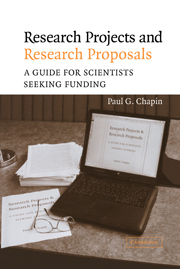Book contents
- Frontmatter
- Contents
- Foreword
- Acknowledgments
- Introduction
- 1 Selecting a Research Topic
- 2 Project Planning
- 3 Identifying Funding Sources
- 4 Special Funding Mechanisms
- 5 Writing a Proposal
- 6 Research Ethics and Responsibilities
- 7 The Natural History of a Proposal
- 8 “We Are Happy/Sorry to Inform You …”
- 9 Managing Your Grant
- Appendix A Glossary of Acronyms
- Appendix B Useful URLs
- Index
7 - The Natural History of a Proposal
Published online by Cambridge University Press: 14 July 2009
- Frontmatter
- Contents
- Foreword
- Acknowledgments
- Introduction
- 1 Selecting a Research Topic
- 2 Project Planning
- 3 Identifying Funding Sources
- 4 Special Funding Mechanisms
- 5 Writing a Proposal
- 6 Research Ethics and Responsibilities
- 7 The Natural History of a Proposal
- 8 “We Are Happy/Sorry to Inform You …”
- 9 Managing Your Grant
- Appendix A Glossary of Acronyms
- Appendix B Useful URLs
- Index
Summary
I've Written My Proposal – Now What?
After you've invested the large amount of time and effort it took to write a proposal, your work is done for a while, but your worrying is just beginning. That's a natural reaction to the situation, and there's no way to make it go away entirely, but it may help somewhat to understand the process your proposal goes through between the time it leaves your hands and the time, months later, when you learn from the program officer whether you'll receive the grant you've requested or not. In this chapter we'll describe that process as it occurs at one funding agency, the NSF. Other funding agencies will be similar in some respects and different in others; you can learn about their review procedures from their Web sites, and by talking to their program officers.
The Sponsored Projects Office
The first stop on your proposal's journey is the SPO at your institution. Hopefully you've been working with them while developing your proposal, as we have strongly recommended in earlier chapters, so that it doesn't come to them as a complete surprise. It's their job to review the proposal to make sure that it conforms to the requirements of your institution and of the funding agency; that it has received the requisite official approvals; and that the budget is complete and accurate, including fringe benefits and indirect costs at the prescribed levels.
- Type
- Chapter
- Information
- Research Projects and Research ProposalsA Guide for Scientists Seeking Funding, pp. 109 - 122Publisher: Cambridge University PressPrint publication year: 2004



